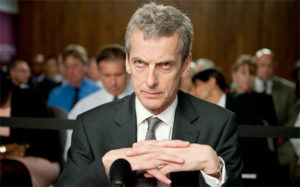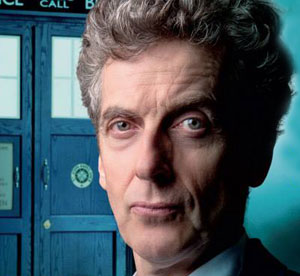Costuming Capaldi’s Doctor
Guest contributor Victor Wong offers some thoughts on how Peter Capaldi’s Doctor might look.
Since the announcement of Peter Capaldi as the upcoming 12th Doctor, there’s been a fair bit of speculation, not just on how this new incarnation should be played, but what his eventual costume should look like. Fans have been photoshopping images of Capaldi clad in their idea of the Doctor’s new ensemble. Since we’re not likely to see the final version before next month at least, I thought it would be worthwhile to set down some ideas that I believe will govern the final design for 12’s debut outfit. Starting with…
The Name Of The Doctor

If there is one thing that the 12th Doctor’s outfit absolutely must do, it has to communicate the idea that the person wearing it is, indeed, a “Doctor.”
You might think, “well, it’s obvious, right?” Not quite. Because, well, what does the word “doctor” mean? Healer? Great Warrior? The man who makes things better? Nope.
The word doctor has its roots in the Latin docere, meaning “to teach” or “to impart knowledge.” That means, whenever the Doctor says “Hello, I’m the Doctor” to a new character, that character must automatically believe he’s meeting a person with (a) a lot of stuff in his head and (b) the ability to explain what’s going on. He doesn’t have to know, or even care, that this “doctor” is a Gallifreyan Time Lord, an owner-operator of a spacecraft, or even a grandparent to a overly bright girl : all that matters is that the new person accepts the Doctor as a “doctor,” i.e. a person of learning.
And, since in our culture the title of “doctor” is bestowed by a degree-granting post-secondary institution, I would argue that of all the places on Earth where the Time Lord could find himself, the one spot where he would appear to be “at home” (apart from you-know-where) would be the campus of an established university or college. This gives us a quick-and-dirty test for the propriety of the Doctor’s outfits: can somebody dressed like that go into a college auditorium and give a serious lecture before undergraduates?
The first four Doctors could pass that test readily, as could the Seventh, Tenth and Eleventh. The Eighth could possibly do it if he were discussing English literature. The Fifth might be able to do it if the class in question was in the early 1980s, with the advent of the fashion movement known as “prep school” or “preppy.” The only two that couldn’t work would be the Sixth (too much resemblance to a circus clown) and the Ninth (more akin to a street warrior).
No Uniformity
 One sure bet about Capaldi’s Doctor: he won’t be wearing a uniform.
One sure bet about Capaldi’s Doctor: he won’t be wearing a uniform.
You might think that’s obvious: the Doctor’s not a member of any organized formal unit, military or otherwise. But there are uniforms, and then there are uniforms. Case in point: Capaldi’s former role of Malcolm Tucker in The Thick of It.
Malcolm, at work, wears a tailored suit, usually in a neutral color with appropriately coloured necktie. That outfit communicates an all-business attitude to the viewer, but it’s also what we expect to see from a contemporary politician or businessman. And because there are a lot of people in Malcolm’s field of work, wearing more or less the same thing, the “power suit” is in fact a uniform, one whose concept is encapsulated in the Japanese notion of “salaryman” or white collar worker.
Contrast that with the suit worn by David Tennant’s Tenth Doctor. The jacket and trousers aren’t as tailored as Tucker’s, and the color scheme is a little too much on the sharp side, to give the impression that its wearer is a sharp businessman or works for a major organization. Tucker’s suit is more of a uniform than Ten’s, because Tucker has to meet society’s expectations of his position and the Doctor… doesn’t.
You’ll find this with entrepreneurs, or artists, or other self-employed professionals: they have more flexibility in their choice of ensemble with which they present themselves to the world. Capaldi’s Doc will fit in this vein.
The Shadow Knows
 Or rather, the silhouette – the physical outline of a character, where the features are “blacked out” or obscured. A character with a good silhouette will be instantly recognizable on screen, even if the light is behind him and the viewer cannot see his face.
Or rather, the silhouette – the physical outline of a character, where the features are “blacked out” or obscured. A character with a good silhouette will be instantly recognizable on screen, even if the light is behind him and the viewer cannot see his face.
All of the previous Doctors have good silhouettes, meaning a viewer will have few problems recognizing them from the shadows they cast. You could identify them by the shadows of their hairstyles (all the Classic Doctors), hats (particularly the Fourth and Seventh), outerwear (Three’s cloak and Ten’s coat), and even accessories (Four’s scarf, Five’s celery pin).
If we’re to expect anything from Capaldi’s forthcoming outfit, it’s to find the details that let his Doctor establish a unique silhouette that stands out from the others. The previous Doctors can certainly influence a detail (such as Five’s plimsolls and Ten’s runners), but we shouldn’t expect him to adapt or resurrect Four’s scarf or Seven’s hat. He needs his own look for his unique silhouette.
Avoiding Anachronism
 Another quality of the Doctor’s look: with few exceptions, the designers have aimed for a classic look, one that tends to fit a variety of historical periods but most especially the age from the late 19th to 21st century. This means avoiding some anachronisms.
Another quality of the Doctor’s look: with few exceptions, the designers have aimed for a classic look, one that tends to fit a variety of historical periods but most especially the age from the late 19th to 21st century. This means avoiding some anachronisms.
I can already hear a few fans of the Classic Series clearing their throats. “What are you talking about? The Doctor should always dress in an Edwardian fashion!”
Um … no. Actually, the Doctor’s style is more aptly described as “neo-Edwardian.” Let me quote you something to show you what I mean:
“The stranger was middle-aged, rosy, well-fed, and clothed rather foppishly in the neo-Edwardian fashion – turned-up cuffs to his dark-blue four-buttoned coat, a pearl pin in a heavy silk cravat, spotless wing collar, cufflinks formed of what appeared to be antique coins, pince-nez on a thick black ribbon.”
The description is of a Doctor Fanshawe, an expert on antique jewelry. He appears in the short story “Property of a Lady,” written by Ian Fleming and featuring his famous special agent James Bond. And this short story was first published in 1963 – the year Doctor Who made its debut. Which makes Dr. Fanshawe a contemporary of the first Doctor. Coincidence? Not at all.
The First Doctor and Fanshaw are examples of a stock character in British contemporary culture: the gentleman scientist, the upper-class professional academic who wears formal clothing outside the laboratory as a way of affirming his importance. Such characters will appear in popular culture right up to the 1970s, and include Dr. Beavis from the episode “Spearhead from Space.” (He’s the formally dressed physician specialist whose cape, hat and car are –er – appropriated by the freshly regenerated Third Doctor.)
 The character occurs often enough in films, books and television that William Hartnell’s outfit serves as a form of visual shorthand for the first-time viewer: instead of being a historical Edwardian, he’s the archetypal mad scientist with a time machine. The fashion is eccentric, yes – but not really an anachronism. It’s not until the 1980s and the advent of the Fifth to Eighth Doctors that historical, Edwardian/Victorian fashion plays a super-strong influence on his clothing.
The character occurs often enough in films, books and television that William Hartnell’s outfit serves as a form of visual shorthand for the first-time viewer: instead of being a historical Edwardian, he’s the archetypal mad scientist with a time machine. The fashion is eccentric, yes – but not really an anachronism. It’s not until the 1980s and the advent of the Fifth to Eighth Doctors that historical, Edwardian/Victorian fashion plays a super-strong influence on his clothing.
Until the last series of the Eleventh Doctor, the Revived Series has clad the Doctor in more contemporary fashions, items more likely to be found in a men’s clothing store than a fancy-dress shop. Furthermore, even the frock coat worn by the Eleventh is rooted in its resurgence, of sorts, as an item for formal wear.
This use of modern clothing serves a purpose: it plants the Doctor solidly in the here and now for his explorations of the space-time continuum, whereas a return to full-blown Edwardian or Victorian outfits would overemphasize a sentiment for the past. Which is fine for historical stories, but not for contemporary adventures.
Conclusion
The 12th Doctor needs an outfit that (a) identifies him quickly as a man of knowledge, (b) looks distinctive but not overly fashionable, (c) gives him a strong silhouette, and (d) isn’t too rooted in the past. Bit of a tall order for Wardrobe, but I’m sure they’ll be able to come up with something that’ll surprise us.








